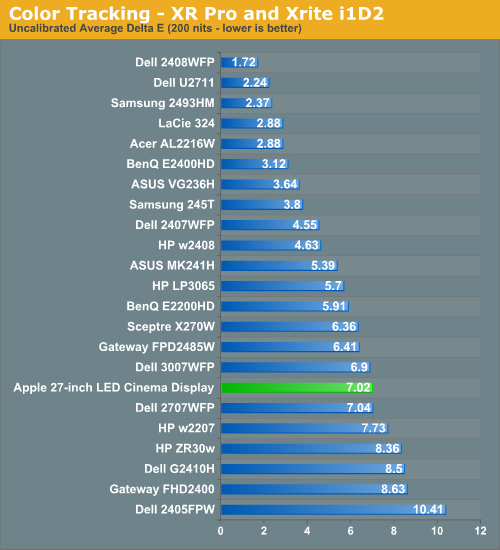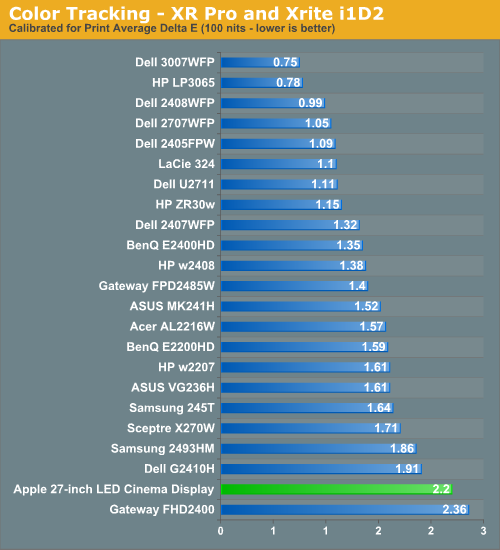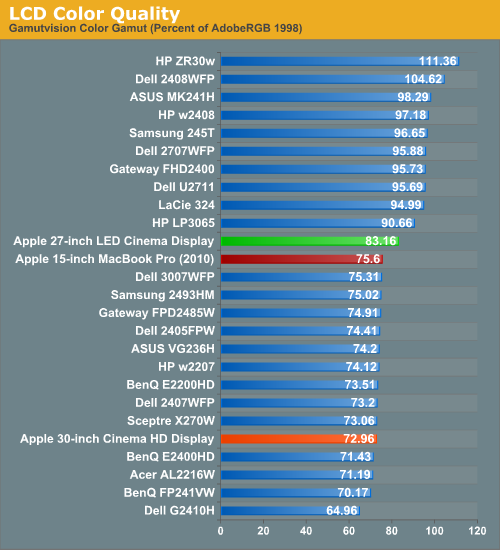Apple 27-inch LED Cinema Display Review
by Anand Lal Shimpi on September 28, 2010 12:15 AM EST- Posted in
- Displays
- Mac
- Apple
- Cinema Display
Color Quality
We report two main quality metrics in our display reviews: color accuracy (Delta-E) and color gamut. Color gamut refers to the range of colors the display is able to represent with respect to some color space. In this case, our reference is the AdobeRGB 1998 color space, which is larger than the sRGB color space. So our percentages are reported with respect to this number, and larger is generally better.
Color accuracy (Delta E) refers to the display’s ability to display the correct color requested by the GPU and OS. The difference between the color represented by the display, and the color requested by the GPU is our Delta-E, and lower is better here. In practice, a Delta E under 1.0 is perfect - the chromatic sensitivity of the human eye is not great enough to distinguish a difference. Moving up, a Delta E of 2.0 or less is generally considered fit for use in a professional imaging environment - it isn’t perfect, but it’s hard to gauge the difference. Finally, Delta E of 4.0 and above is considered visible with the human eye. Of course, the big consideration here is frame of reference; unless you have another monitor or some print samples (color checker card) to compare your display with, you probably won’t notice. That is, until you print or view media on another monitor. Then the difference will no doubt be apparent.
As I mentioned in our earlier reviews, we’ve updated our display test bench. We’ve deprecated the Monaco Optix XR Pro colorimeter in favor of an Xrite i1D2 since there are no longer up-to-date drivers for modern platforms.
For these tests, we calibrate the display and try to obtain the best Delta-E we can get at both 200 nits of brightness for normal use, and 100 nits for print brightness. We target 6500K and a gamma of 2.2, but sometimes the best performance lies at native temperature and another gamma, so we try to find what the absolute best performance could be. We also take an uncalibrated measurement to show performance out of the box using either the manufacturer supplied color profile, or a generic one with no LUT data. For all of these, dynamic contrast is disabled.


Uncalibrated the display's color accuracy isn't very good. I found the 27-inch LED Cinema Display to be way too blue and green out of the box, calibrated the display did much better:


The 27-inch LED Cinema Display isn't going to be winning any awards for color reproduction but it's good enough when calibrated.


Curiously enough, dropping brightness down to 100 nits caused a noticeable reduction in color tracking. The average delta E went up to 2.2 while most of the 27's competitors remained about the same. The 27-inch behaves very differently depending on what brightness setting you have it on.

Apple managed to do relatively well with the WLED backlight but it's still no match for the color gamut you get from any of the CCFL backlit displays. Note that my old 30 hasn't aged well, it's only able to cover roughly 73% today.











93 Comments
View All Comments
Hln98 - Tuesday, September 28, 2010 - link
Does the system fonts on this appear too small like the iMac 27 inch? I have the Apple 24 inch LED now and love it since I can see the font. I want to get the new 27 inch but if it's like the iMac 27 inch, I will pass.Please confirm.
Ogopogo - Tuesday, September 28, 2010 - link
I guess the Apple premium (perhaps excepting accessories) has really gone away over the years. Now all the major manufacturers have the same business model - a little distinctive design then outsource to Asia - so prices come back a wash. I remember when Apple wanted $1-2k more for their 30" monitor than anyone else. Now this comes in cheaper than the Dell U2711.Juddog - Tuesday, September 28, 2010 - link
I don't understand why the manufacturers are pushing for such high density displays - for me, 1920 x 1200 at 27 inches is the ideal resolution. Mostly because of font sizes and such, 2560 x 1440 just makes things seem too dang small.I don't known if it's a factor of getting old, but most people I work with seem to think the same.
Spivonious - Tuesday, September 28, 2010 - link
It's because things just look better at a higher DPI. If the fonts are too small, change the font size. Windows 7 has great support for this. My old 17" CRT (I'm too picky to use a TN panel LCD, and too cheap to spend $1000 on a nice IPS LCD) is 130dpi and things just look so much clearer when I run Windows at 125% font size. The number of apps that don't recognize the setting is much smaller than it used to be. Pretty much all apps that were released in the past 5 years support high DPI.I can actually see large differences at 12pt between fonts like Arial, Cambria, and Verdana, where on 96dpi they were very slightly different.
DanaG - Wednesday, September 29, 2010 - link
I have a high-dpi display, and can't use any desktops, because they all have crap DPI.<link removed because the damn comment system thinks this comment is spam>
Anyway, it was "rant-hdtv-has-ruined-the-lcd-display-market-or-i-want-my-pixels-and-dpi-now"
See my comment near the bottom.
"This comment is apparently spam and we do not allow spam comments."
What the hell, Anandtech? What sort of garbage do I have to put in my post to get it to not count as "spam"? How about more random words? Damnit...
n0x1ous - Tuesday, September 28, 2010 - link
I wish someone would make a 30 inch 2560 x 1600 TN so I could actually afford one. Im surprised Asus or Alienware or one of those doesn't get with some OEM and make a $500 30 inch TN for us gamers who don't need all the perfect viewing angles/colors etc......I am ready for more rez (currently on 19x12) but just can't stomach the 10 benjamins to get to 25x16
Tros - Tuesday, September 28, 2010 - link
I disagree, strongly.Your display is just as important as what video card you have driving it, simply because if you're in dark corridors, and the viewing angle makes more of a difference than the video card, then the rendered picture is worthless. Likewise, vibrant colors tend to get a faster response from the brain than colors that are washed out and leave the image ambiguous without looking at it for a few seconds.
I've got two solutions:
1) Go with a projector. Variable screen size, plus a low resolution to keep frames high.
2) Stick with the stuff in your price range.
It's this kind of demand that gets us huge, high resolution screens, with images worse than current solutions.
I'm disappointed with this offering from Apple, because it really is all-glitz and not much substance. As a consumer, I expect to pay a price and get a superior product. And I acknowledge that the price is ridiculous, but at least I don't have to play the "mixed bag" game. I am not wow'ed by the ability to pay a lower price and get something "like good". That's not Apple-like at all.
TegiriNenashi - Tuesday, September 28, 2010 - link
Second it. The price of 30" has been frozen at ~$1200 level for what, 3 years already? Those who claim that the cost of IPS panel is high, should look no further than LCD TVs, which prices steadily declined in all size categories. Today one can buy two good-enough 46" TVs (they are IPS!) for a price of one 30" monitor.BZDTemp - Thursday, September 30, 2010 - link
It's harder to make more pixels perfect so some of the cost is found there but it's also a question of to little a market so that mass production effects are limited.To many people are simply content with what they got and the majority looks at screen size vs. prices and then get the terrible TN panels. It's like in the old days with CRT's where most people ran them at 60 Hz because that was Windows default not knowing good screens could do so much better.
Dustin Sklavos - Tuesday, September 28, 2010 - link
Disagree. TN technology starts to really hit limitations at around 24", when you get bigger than that you start to lose uniformity and the sweet spot for viewing gets that much harder to find. A 30" TN panel would look awful.